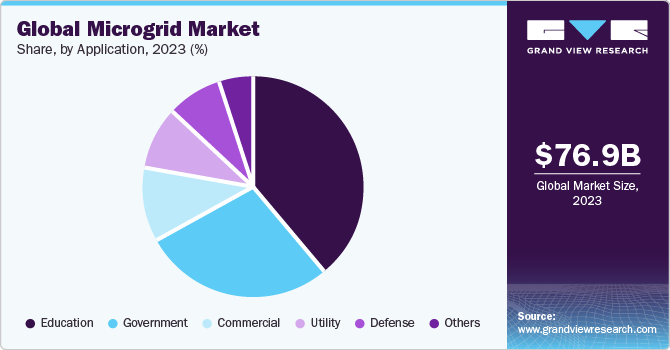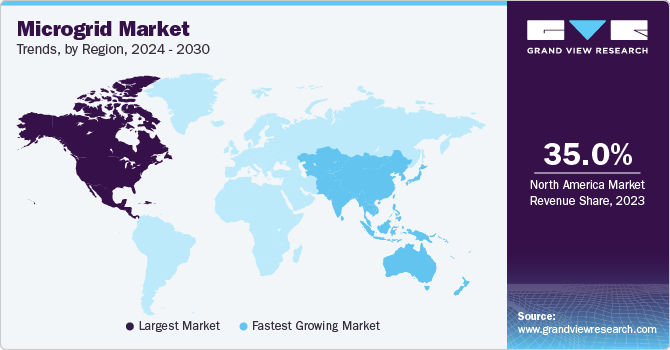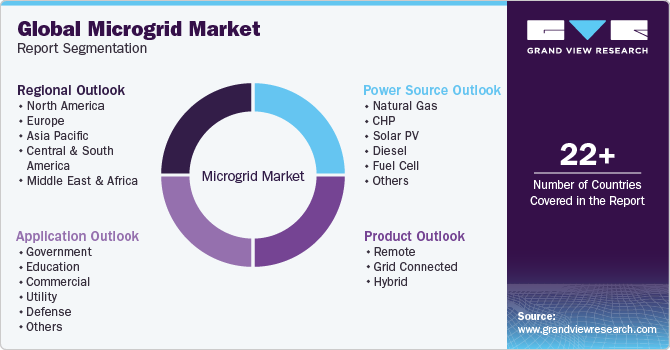
Microgrid Market Size, Share & Trends Analysis Report By Power Source (Natural Gas, CHP, Fuel Cell), By Product (Remote, Grid Connected, Hybrid), By Application (Education, Government, Commercial), By Region, And Segment Forecasts, 2024 - 2030
- Report ID: GVR-1-68038-527-4
- Number of Report Pages: 114
- Format: PDF, Horizon Databook
- Historical Range: 2018 - 2022
- Forecast Period: 2024 - 2030
- Industry: Energy & Power
Microgrid Market Size & Trends
The global microgrid market size was estimated at USD 76.88 billion in 2023 and is expected to grow at a compound annual growth rate (CAGR) of 17.1% from 2024 to 2030. Rising power demand in developing countries including Mexico, China, India, and Russia as a result of growth in household and industrial sectors is expected to be a driving force. A microgrid is a local electric system, which can provide power either in parallel or isolation from electric grids. Shifting inclination from remote central station power plants to more localized and distributed generation for enhanced reliability, resiliency, and energy in cities, communities, and campuses is projected to have a substantial impact on market growth.

These electrical distribution services are used for providing enhanced local resiliency and improvement of operation & stability of the regional electric grid. Furthermore, the utilization of renewable resources for power generation is expected to upscale the requirements of microgrids in the near future. The rising importance of the captive power generation system in the manufacturing sector to reduce the reliance on electricity supply from the regional electric grid is expected to remain a key driving factor. Growing awareness about power generation using alternative renewable sources including wind, solar, and hydrogen is projected to have a positive impact on market growth.
Over the past few years, population growth and urbanization in emerging markets have resulted in increasing government spending on infrastructure development. It is expected to play a crucial role in promoting power demand, thereby boosting the microgrid industry growth. Rising spending on the development of new prototypes of smart microgrids through the implementation of the Galvin Energy Initiative by The Galvin Project Inc. is expected to open new markets. Furthermore, the emergence of the U.S. and Canada as shale gas production destinations due to the increased adoption of hydraulic fracturing technology is projected to ensure the access of power sources to buyers.
Power Source Insights
The Combined Heat & Power (CHP) power source segment dominated the global market and accounted for more than 37.0% of the overall revenue share in 2023. Shifting preference from conventional Separate Heat & Power (SHP) system to energy generation from single fuel is expected to have a substantial impact on the segment growth. Fuel cell is expected to register a significant growth rate over the forecast period. The ability of fuel cells to operate at high temperatures along with negligible electrolytic loss is expected to promote its application scope in the near future.
Favorable support by developed countries including the U.S., Germany, UK, and Japan aimed at upscaling the power generation output from solar energy will have a positive impact. Furthermore, technological advancements regarding the development of organic solar PV modules are expected to provide new growth opportunities over the next few years. The diesel power source segment is estimated to register a moderate growth rate during the forecast period on account of stringent regulations aimed at limiting power generation from fossil fuels. In addition, the high adoption rate of diesel power sources for electricity generation in the manufacturing sectors of developed economies is expected to be a favorable factor.
Product Insights
The grid-connected product segment dominated the global market and accounted for more than 65.0% of the overall revenue share in 2023. The rising popularity of smart micro-grid-connected PV systems to provide electricity to consumers by reducing transmission losses is expected to have a substantial impact. Over the past few years, North Power Systems have been utilizing technology, which integrates their wind turbines with solar PV, diesel gensets, or other power sources of the microgrid. This hybrid technology has been used in grid projects located in Hawaii, Alaska, the Bahamas, and Antarctica.
Grid-connected microgrids are becoming increasingly popular in rural and urban areas where access to the main grid is limited or non-existent. The growth of distributed energy resources, such as solar panels and energy storage systems, has also fueled the growth of grid-connected microgrids. Moreover, microgrids are becoming more common as communities look for ways to reduce their carbon footprint and increase their energy independence. Defense microgrids are also gaining popularity as the defense looks for ways to reduce its reliance on traditional fuel sources. Remote microgrids are being used in developing countries to provide electricity to remote areas.
Application Insights
The education segment dominated the market and accounted for more than 37.0% of the overall revenue in 2023. Rising government spending on the improvement of education infrastructure for ensuring school education in rural areas in developing countries including China and India is expected to have a positive impact. Extensive requirements of power supply for ensuring lighting, Heat Ventilation Air Conditioning (HVAC), and operating electronic goods in hospitals, corporate offices, and retail outlets are projected to have a high impact. Commercial applications is one of the largest segments of the market. Microgrids are being used by businesses to reduce their reliance on the main grid and improve energy efficiency.

Microgrids are also being used to provide backup power during outages, which is especially important for critical facilities like hospitals and data centers, whereas the defense is increasingly using microgrids to reduce its reliance on traditional fuel sources and improve energy security. Microgrids are being used to power defense bases and remote installations, providing reliable and secure power in challenging environments. Other applications of microgrids include healthcare facilities, residential and public infrastructure like streetlights and traffic signals. Microgrids are being used in these applications to improve energy efficiency, reduce costs, and provide backup power during outages.
Regional Insights
North America led the global market and accounted for more than 35.0% of the overall revenue in 2023. The high adoption rate of captive power generation methods in the industrial and municipal sectors of the U.S. for reducing reliance on the government-controlled power supply is expected to have a substantial impact. The positive outlook for manufacturing and construction sectors in the major markets including China and India owing to regulatory support for promoting investments on a domestic level is expected to be a major factor driving the growth. The strong foothold of mineral processing units of silver and copper in Peru and Chile, on account of the abundance of mineral reserves, is expected to expand the market size of power distribution systems over the next eight years.

Asia Pacific is projected to witness a significant growth rate from 2023 to 2030. The positive outlook for manufacturing and construction sectors in the major markets including China and India owing to regulatory support for promoting investments on a domestic level is expected to be major driving factors. The Middle East and Africa region is also seeing growth in the microgrid industry, driven by a need to improve energy security and reduce reliance on traditional fuel sources. Countries like Saudi Arabia and the United Arab Emirates are investing in microgrids to power remote oil and gas facilities and improve energy access in rural areas.
Key Microgrid Company Insights
The global market is significantly fragmented owing to the presence of a large number of large and small-scale manufacturers. Global players face intense competition from each other as well as from regional players, who have strong awareness about the regulations and suppliers in the markets. Prominent players are continuously engaged in merger & acquisition activities along with the expansion of manufacturing facilities, investments in R&D activities and seeking opportunities to vertically integrate across the value chain. In March 2022, GE Renewable Energy’s Grid Solutions, in partnership with BOND Civil & Utility Construction, was awarded an Engineering, Procurement, and Construction (EPC) contract from Empire Wind to design and build an onshore digital substation for Empire Wind New York’s first offshore wind farm.
Key Microgrid Companies:
- ABB
- Siemens AG
- General Electric
- Eaton Corp.
- Exelon
- Honeywell International
- NRG International
- Anarbic
- Pareto
- Spirae
- Northern Power
- Viridity
Microgrid Market Report Scope
|
Report Attribute |
Details |
|
Market size value in 2024 |
USD 87.17 billion |
|
Revenue forecast in 2030 |
USD 224.34 billion |
|
Growth rate |
CAGR of 17.1% from 2024 to 2030 |
|
Base year for estimation |
2023 |
|
Historical data |
2018 - 2022 |
|
Forecast period |
2024 - 2030 |
|
Report updated |
November 2023 |
|
Quantitative units |
Volume in mw, revenue in USD million/billion, and CAGR from 2024 to 2030 |
|
Report coverage |
Volume forecast, revenue forecast, company ranking, competitive landscape, growth factors, trends |
|
Segments covered |
Power source, product, application, region |
|
Regional scope |
North America; Europe; Asia Pacific; Central & South America; Middle East & Africa |
|
Country scope |
U.S.; Canada; Mexico; Germany; China; India; Brazil |
|
Key companies profiled |
ABB; Siemens AG; General Electric; Eaton Corp.; Exelon; Honeywell International; NRG International; Anarbic; Pareto; Spirae; Northern Power; Viridity |
|
Customization scope |
Free report customization (equivalent up to 8 analyst’s working days) with purchase. Addition or alteration to country, regional & segment scope |
|
Pricing and purchase options |
Avail customized purchase options to meet your exact research needs. Explore purchase options |
Global Microgrid Market Report Segmentation
This report forecasts volume and revenue growth at global, regional, and country levels and provides an analysis of the latest industry trends in each of the sub-segments from 2018 to 2030. For this study, Grand View Research has segmented the global microgrid market report based on power source, product, application, and region:

-
Power Source Outlook (Volume, MW; Revenue, USD Million, 2018 - 2030)
-
Natural Gas
-
CHP
-
Solar PV
-
Diesel
-
Fuel Cell
-
Others
-
-
Product Outlook (Volume, MW; Revenue, USD Million, 2018 - 2030)
-
Remote
-
Grid Connected
-
Hybrid
-
-
Application Outlook (Volume, MW; Revenue, USD Million, 2018 - 2030)
-
Government
-
Education
-
Commercial
-
Utility
-
Defense
-
Others
-
-
Regional Outlook (Volume, MW; Revenue, USD Million, 2018 - 2030)
-
North America
-
U.S.
-
Canada
-
Mexico
-
-
Europe
-
Germany
-
-
Asia Pacific
-
China
-
India
-
-
Central & South America
-
Brazil
-
-
Middle East & Africa
-
Frequently Asked Questions About This Report
b. The global microgrid market size was estimated at USD 76.88 billion in 2023 and is expected to reach USD 87.17 billion in 2024.
b. The global microgrid market is expected to grow at a compounded annual growth rate of 17.1% from 2024 to 2030 to reach USD 224.34 billion by 2030.
b. North America dominated the microgrid market with the highest share of 35.79% in 2023. This is attributable to the high adoption rate of captive power generation methods in the industrial and municipal sectors of the U.S. for reducing the reliance on the government-controlled power supply is expected to have a substantial impact.
b. Some key players operating in the microgrid market include Lockheed Martin Corporation, Siemens AG, GE, Power Analytics, ABB Group, Microgrid LLC, Spirae Inc, Schneider Electric, ZBB Energy Corporation, Pareto Energy, Toshiba Corporation, Honeywell International Inc., Echelon Corporation and Viridity Energy Inc.
b. Key factors driving the microgrid market growth include Shifting inclination from remote central station power plants to more localized and distributed generation for enhanced reliability, resiliency and energy in cities, communities and campuses is projected to have a substantial impact.
We are committed towards customer satisfaction, and quality service.
"The quality of research they have done for us has been excellent."




